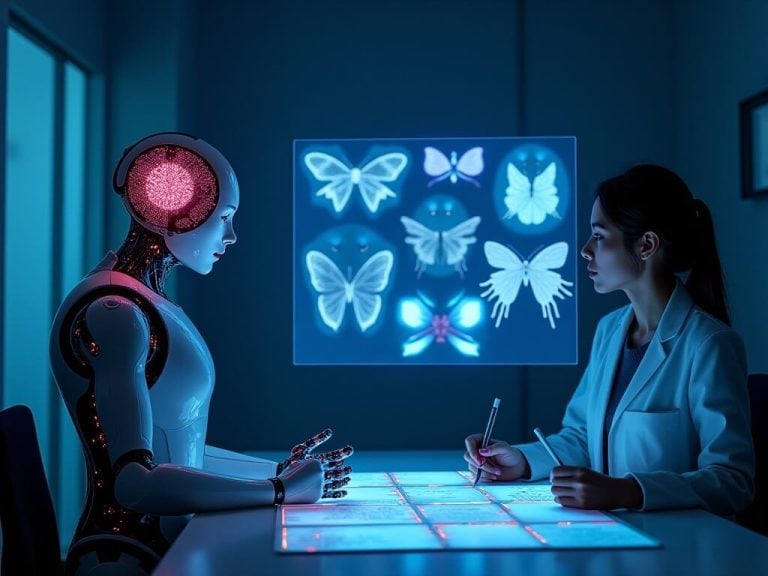
In a quiet research lab at Imperial College London, Professor José R Penadés and his team had been studying superbugs—antibiotic-resistant bacteria—for a decade. They were pursuing a theory about how these dangerous microbes acquire their defensive capabilities, a puzzle with massive implications for global health. Then something extraordinary happened.
Google’s newly released co-scientist AI, powered by Gemini 2.0, needed just 48 hours to reach the same conclusion that took the scientists ten years of painstaking research. Not only did the AI confirm their theory, but it also proposed additional mechanisms they hadn’t considered—including one so novel that the team is now actively studying it.
“I was shopping with somebody, I said, ‘please leave me alone for an hour, I need to digest this thing,'” Penadés told reporters. “I feel this will change science, definitely.”
This remarkable acceleration in scientific discovery is not an isolated incident. Across research labs, tech companies, and creative studios, artificial intelligence is compressing timelines from years to days—and sometimes hours. As AI capabilities grow exponentially with each new generation of models, we’re witnessing the emergence of what can only be called “the acceleration effect”—a fundamental shift in how quickly humans can discover, create, and innovate when partnered with advanced AI systems.
The Scaling Challenge: OpenAI’s GPT-4.5 “Orion”
OpenAI recently unveiled GPT-4.5, codenamed “Orion,” its largest AI model to date. Built using significantly more computing power and data than any previous OpenAI model, GPT-4.5 represents both the promise and the challenges of scaling up traditional AI training approaches.
What makes GPT-4.5 interesting isn’t just its size but what its development reveals about the future of AI architecture. The industry has long operated on the assumption that bigger models trained on more data would continue to yield proportionally better results—a principle known as “scaling laws.” But GPT-4.5’s mixed performance suggests we may be approaching the limits of this approach.
While GPT-4.5 demonstrates improved factual accuracy, reduced hallucinations, and what OpenAI describes as “higher emotional intelligence” compared to smaller models, it falls short of newer AI “reasoning” models on several important benchmarks. On difficult academic tests like AIME and GPQA, GPT-4.5 is outperformed by reasoning-focused models like DeepSeek’s R1, Anthropic’s Claude 3.7 Sonnet, and even OpenAI’s own o3-mini.
Perhaps most telling is GPT-4.5’s extraordinary computational cost. OpenAI is charging developers $75 for every million input tokens (roughly 750,000 words) and $10 per million output tokens for GPT-4o. This pricing reflects not just business strategy but the immense resources required to train and run such massive models.
This cost-benefit equation has industry experts reconsidering the path forward. Former OpenAI chief scientist Ilya Sutskever has claimed “we’ve achieved peak data” and that “pre-training as we know it will unquestionably end.” The future, it seems, may belong not to ever-larger models but to more efficient architectures that prioritize reasoning capabilities over raw size.
Science at Hyperspeed: AI Transforming Research
While the tech industry grapples with scaling challenges, researchers across disciplines are discovering that AI can dramatically accelerate their work—sometimes with surprising results.
Climate Research: From Data-Rich to Insight-Rich
At Oregon State University’s College of Earth, Ocean, and Atmospheric Sciences (CEOAS), researchers have long struggled with what Christopher Sullivan, the college’s director of research and academic computing, calls being “data-rich and information-poor.” The college’s work spans ocean and land, studying everything from plankton and seabirds to freshwater ecosystems and carbon cycles, generating immense datasets that traditional methods struggle to analyze effectively. In partnership with Dell Technologies, CEOAS is now using AI to transform their approach. Their research vessels, including the newly outfitted Regional Class Research Vessel Taani, are equipped with advanced computing systems that enable AI-driven analysis at sea. Rather than waiting until they return to shore, researchers can now process data in real-time, accelerating discoveries and allowing for adaptive research strategies. “We really want to be doing it in real time because if it takes us too long, the data becomes meaningless,” Sullivan explained. The impact is particularly evident in plankton monitoring, where AI-powered systems can analyze billions of organisms in real-time—a task that would be impossible for human researchers. “There was no way you could possibly have a human quantify that,” Sullivan noted. “Statistically, we’re actually making relevance now, and I have a lot more ability to see the rare species that are not out there in heavy abundance because we’re able to mine through it so rapidly.”Superbug Solutions: From Decades to Days
Perhaps the most dramatic example of AI’s scientific acceleration effect comes from the field of microbiology. The previously mentioned case of Google’s co-scientist AI identifying mechanisms behind superbug resistance in just two days represents a compression factor of approximately 1,800x compared to the decade of human research. What makes this achievement particularly remarkable is that the AI wasn’t provided with the team’s unpublished research—it independently reached the same conclusion based on available scientific literature and its understanding of biological systems. The AI proposed that bacteria that become superbugs can form a tail from different viruses, allowing them to continue spreading across species. It also suggested multiple alternative mechanisms, including one novel approach the researchers had never considered. This case illustrates how AI can synthesize information across vast bodies of scientific literature, identifying connections and patterns that might take human researchers years to discover. The potential implications for medical research are profound—from accelerating drug discovery to developing new treatments for antibiotic-resistant infections.Creative Intelligence: How AI Reimagines Design

Playful Intelligence: AI-Generated Games
A team at New York University has created an AI model that can represent and generate human-like goals by learning from how people create games. The system observed participants inventing playful goals in a virtual room containing various objects, capturing nearly 100 unique games. The AI then learned to create its own goal-oriented games based on the same principles of plausibility and recombination that guided human creativity.
When a new group of participants rated both human-created and AI-generated games, they gave similar scores for fun, creativity, and difficulty—suggesting the AI had successfully captured the essence of human goal creation. This research not only advances our understanding of human cognition but also demonstrates AI’s ability to engage with fundamentally human concepts like play and creativity.
Microsoft Research has taken game generation a step further with Muse, an AI that can dream up entirely new scenarios within existing video games. Trained on roughly 500,000 human gameplay sessions from the multiplayer shooter Bleeding Edge—equivalent to seven years of continuous play—Muse can generate new game scenarios that obey the game’s internal physical rules and respond appropriately to controller inputs.
“What’s groundbreaking about Muse is its detailed understanding of the 3D game world, including game physics and how the game reacts to players’ controller actions,” explained Fatima Kardar, corporate vice president of gaming AI at Microsoft. While Muse is currently limited to scenarios based on Bleeding Edge, its approach could theoretically work with any game given sufficient training data.
Alien Intelligence: AI Chip Design
Perhaps the most striking example of AI’s creative capabilities comes from the field of chip design. Engineering researchers recently demonstrated that AI can design complex wireless chips in hours rather than the weeks it would take human engineers—and the results are baffling in their efficiency.
The AI-designed millimeter-wave wireless chips, used in technologies like 5G modems, took a radically different approach from human designs. Rather than combining existing elements according to established templates, the AI considered each chip as a single artifact and created structures that “look randomly shaped,” according to lead researcher Kaushik Sengupta of Princeton University. “Humans cannot really understand them.”
Yet when manufactured, these incomprehensible designs achieved performance levels beyond those of existing human-created chips. The AI’s approach dispensed with conventional wisdom and templates that have guided human chip designers for decades, instead optimizing for pure performance.
This represents a profound shift in how we approach design problems. Rather than relying on human intuition and incremental improvements to existing designs, AI can explore solution spaces unconstrained by precedent or convention—often finding solutions that human experts would never have considered.
The Mirror of Mind: AI and Rorschach Tests

When researchers gave an AI system the famous Rorschach inkblot test—designed to reveal aspects of human psychology through our tendency to find meaning in ambiguous images—the results offered fascinating insights into both AI perception and human cognition.
The AI system immediately recognized the images as Rorschach inkblots and provided interpretations similar to common human responses—seeing butterflies, bats, or moths in the symmetrical shapes. However, unlike humans, who tend to provide consistent interpretations based on their personal experiences and psychology, the AI would generate different interpretations of the same image when asked multiple times.
This difference highlights a fundamental distinction between human and artificial intelligence. As London-based psychologist Barbara Santini explains: “If an AI’s response resembles a human’s, it’s not because it sees the same thing but because its training data mirrors our collective visual culture.”
The experiment reveals how human perception is shaped by our individual experiences, emotions, and unconscious processes—elements that AI can simulate but not truly possess. As Dr. Chandril Ghosh of the University of Kent notes, “ChatGPT can understand emotions, describe them, and help others make sense of their feelings,” but it doesn’t experience them.
What This Means for Your Organization
As AI continues to transform the speed and nature of discovery across industries, organizations face critical strategic questions:
- How can we identify the areas of our business where AI could most dramatically accelerate innovation?
- What infrastructure, talent, and partnerships do we need to effectively leverage advanced AI capabilities?
- How should our decision-making processes evolve to accommodate the faster pace of AI-enabled discovery?
- What ethical frameworks and governance structures are needed to ensure responsible innovation?
At ePotentia, we specialize in helping organizations navigate these questions and develop strategies to harness the acceleration effect of AI. Our team of AI consultants works across industries to identify high-impact applications, design effective human-AI collaboration models, and build the technical infrastructure needed to support advanced AI capabilities.
The acceleration effect we’re witnessing is just beginning. As AI models become more capable and our approaches to human-AI collaboration more sophisticated, we expect to see even more dramatic compression of discovery timelines. Organizations that prepare now will be positioned to thrive in this new era of accelerated innovation.
The future of discovery is here—and it’s moving faster than ever before.
References
- Butcher, M. (2025, February 27). OpenAI unveils GPT-4.5 ‘Orion,’ its largest AI model yet. TechCrunch. https://techcrunch.com/2025/02/27/openai-unveils-gpt-4-5-orion-its-largest-ai-model-yet/
- Adebayo, K. S. (2025, February 26). Inside Apple’s Massive $500 Billion AI Bet. Forbes. https://www.forbes.com/sites/kolawolesamueladebayo/2025/02/26/inside-apples-massive-500-billion-ai-bet/
- SiliconANGLE. (2025, February 26). AI at sea: Oregon State University partners with Dell to transform climate research. SiliconANGLE. https://siliconangle.com/2025/02/26/ai-powered-research-oregon-state-university-work-sea-delloceansofdata/
- Science Daily. (2025, February 26). AI generates playful, human-like games. Science Daily. https://www.sciencedaily.com/releases/2025/02/250226142050.htm
- BGR. (2025, February). Google’s new AI solves superbug problems in two days – human researchers needed a decade. BGR. https://bgr.com/tech/googles-new-ai-solves-superbug-problems-in-two-days-human-researchers-needed-a-decade/
- Burgess, M. (2025, February 24). We gave an AI a Rorschach test. What it saw in the inkblots offers a window into the human mind. BBC Future. https://www.bbc.com/future/article/20250224-what-happens-when-you-give-an-ai-a-rorschach-inkblot-test
- Live Science. (2025, February). AI-designed chips are so weird that ‘humans cannot really understand them’. Live Science. https://www.livescience.com/technology/computing/humans-cannot-really-understand-them-weird-ai-designed-chip-is-unlike-any-other-made-by-humans-and-performs-much-better
- Singularity Hub. (2025, February 21). This Microsoft AI Studied 7 Years of Video-Game Play. Now It Dreams Up Whole New Game Scenarios. Singularity Hub. https://singularityhub.com/2025/02/21/this-microsoft-ai-studied-7-years-of-video-game-play-now-it-dreams-up-whole-new-game-scenarios/